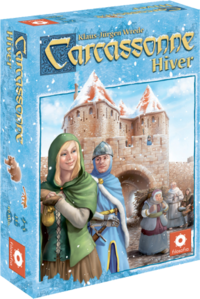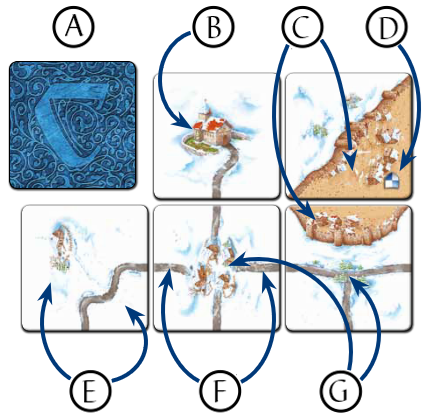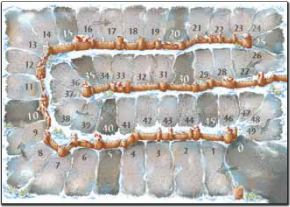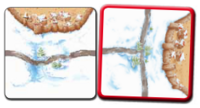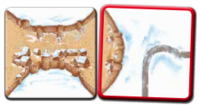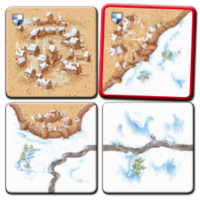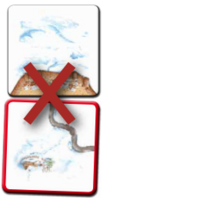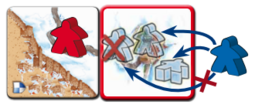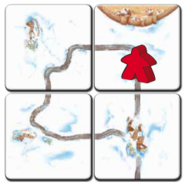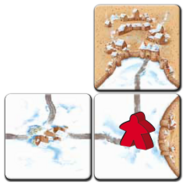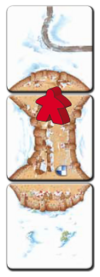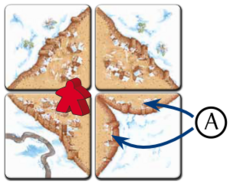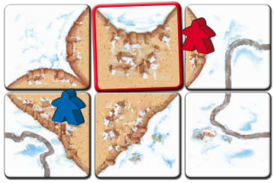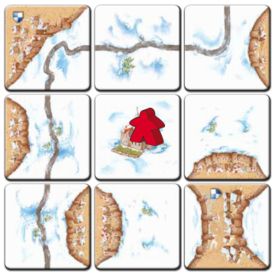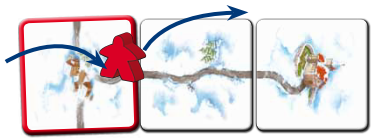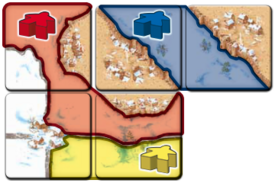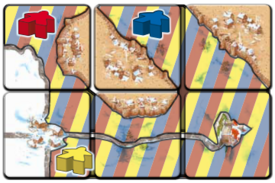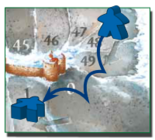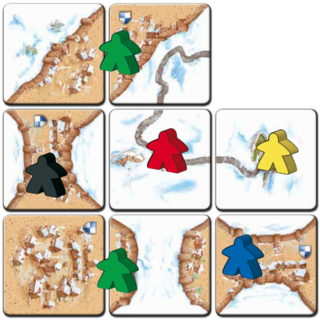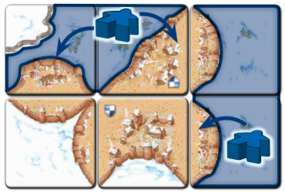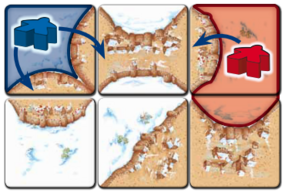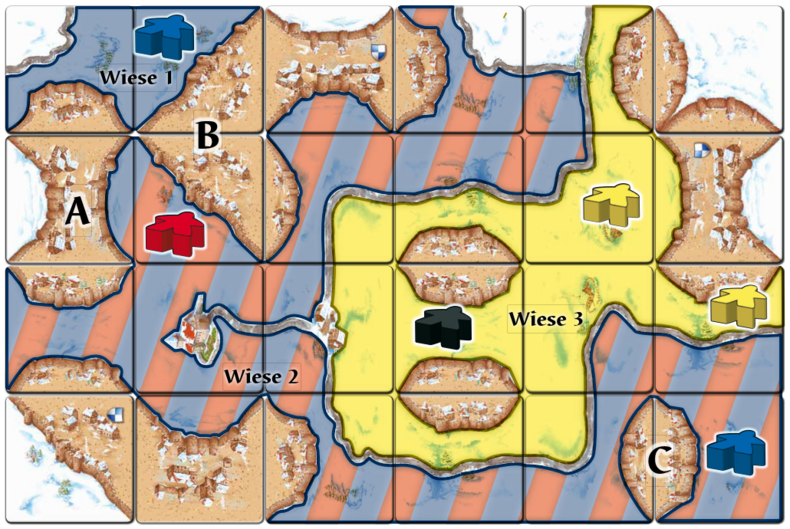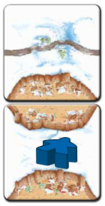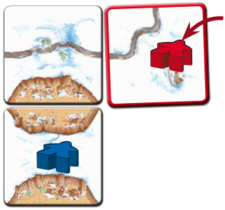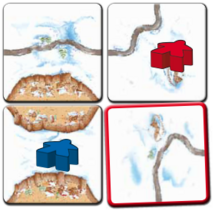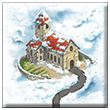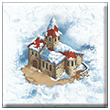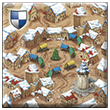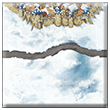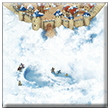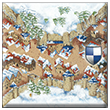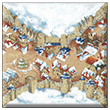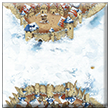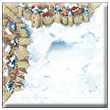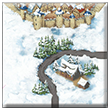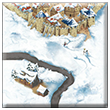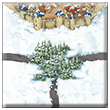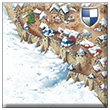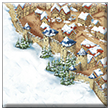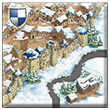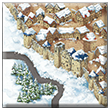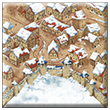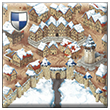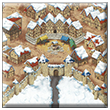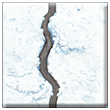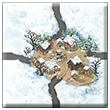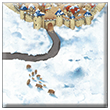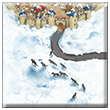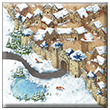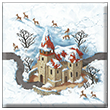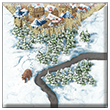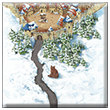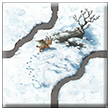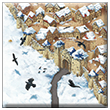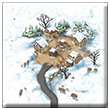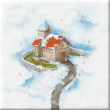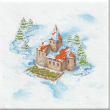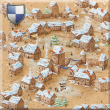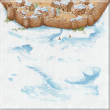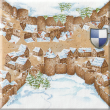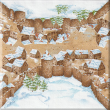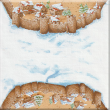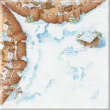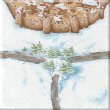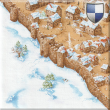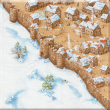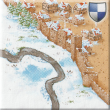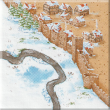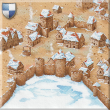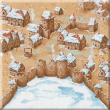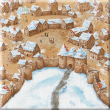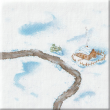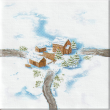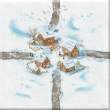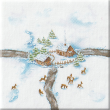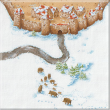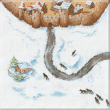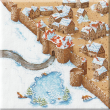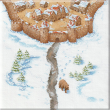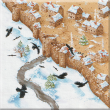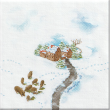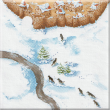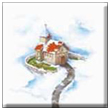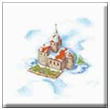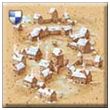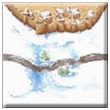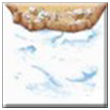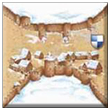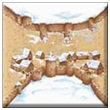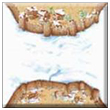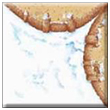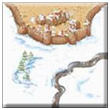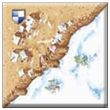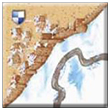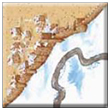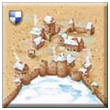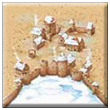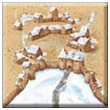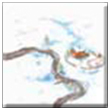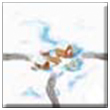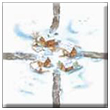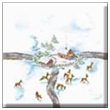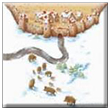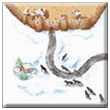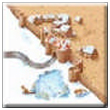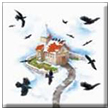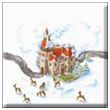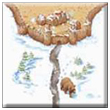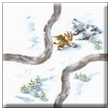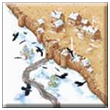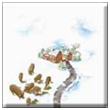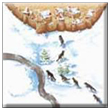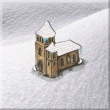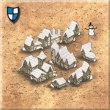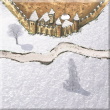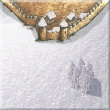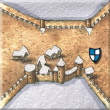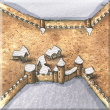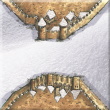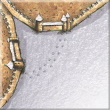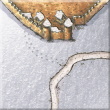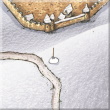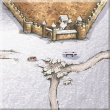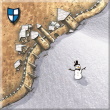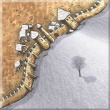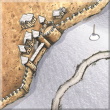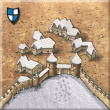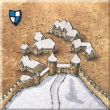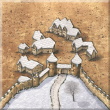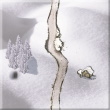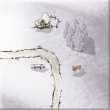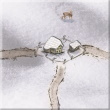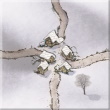Jeu de base (édition Hiver)
The city of Carcassonne in southern France is famous for its unique Roman and Medieval fortifications. The players take their chances with their followers in the cities, cloisters, farms and on the roads around Carcassonne. The development of the land is in their hands, and the skillful deployment of the followers as thieves, knights, monks and farmers is the path to success.
Informations générales et commentaires
Carcassonne: Winter Edition was originally released by Hans im Glück in 2012.
A clever tile-laying game, in a winter coat, for 2 to 5 players, aged 8 and above, by Klaus-Jürgen Wrede.
Matériel
- 72 land tiles (including one with a dark reverse) which depict road, city and field segments, as well as cloisters and crossings.
- 12 land tiles with winter animals on them.
- 40 followers [1] in five colors:
Each follower can be deployed as a knight, monk, thief, or farmer. One follower of each color is used as a scoring marker.
- One scoreboard. This is used to track players' scores
- One rule booklet.
Règles
Aperçu du jeu
The players place the land tiles turn by turn. This leads to the growth of roads, cities, cloisters and farms, to which the players may deploy their followers in order to earn points. As points can be won during the game as well as at the end, the winner will only emerge during the final scoring.
The rules for the winter edition are identical to the normal rules of the game Carcassonne. The 12 additional tiles with animal illustrations are played by the usual rules. [2] [3]
Mise en place
The starting tile is placed in the middle of the table. The remaining tiles are mixed and placed face-down on the table in several stacks, so that each player can access them easily. [4] The scoreboard should be placed at the edge of the table if possible.
Each player chooses a color and receives all eight followers of that color, placing one on the '0' field of the scoreboard as a scoring marker. The remaining seven followers stay with the player for the moment, as his or her supply.
The youngest player decides who starts the game.
Déroulement d’une partie
Play progresses in a clockwise fashion. The player whose turn it is carries out the following actions in the order given:
- The player must draw one new land tile and place it.
- The player may take one follower from his or her supply and deploy it to the tile just placed.
- If any roads, cities, or cloisters are completed through the placement of the tile, they must be scored now.
Then it is the next player's turn.
1. Placement d’une tuile
As their first action, the player must draw a tile from one of the stacks. The tile is then shown to the other players (so they can “advise” the player about where to place it) and placed on the table. The player must take care to observe the following:
- At least one side of the new tile (with a red border in the examples below) must touch one or more tiles already in play. [5] Corner-to-corner placement is not permitted.
In the rare case that a tile cannot legally be placed anywhere, and all players agree, it is removed from the game, and the player draws another. [8]
2. Pose d’un partisan
When the player has placed the tile, he or she may deploy a follower. In doing so the following points must be observed:
- Only one follower may be deployed each turn.
- The follower must come from the player's supply.
- The follower may only be deployed to the tile just placed.
- The player must decide which part of the tile the follower is deployed to [9] [10] as either:
| thief | knight | monk | farmer | ||||
|---|---|---|---|---|---|---|---|
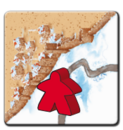 |
or |  |
or |  |
or | 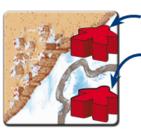 |
here or there |
| on a road segment | in a city segment | on a cloister | in a field. | Lay down your farmers! |
Note: For your first game, it is best to play without the farmers.
- There must be no other follower (not even one belonging to the same player) on the road, city, or field segments connected to the tile just placed. It does not matter how far away the follower is. The following two examples may help to explain:
If a player runs out of followers during the course of play, he or she may only place tiles. But don't panic: you can also get followers back.
Now the player’s turn is over, and it is the turn of the next player on the left.
Exception: If a road, city, or cloister was completed through the placement of the tile, it must now be scored. [11]
3. Évaluation des routes, villes et abbayes
A road is completed when the road segments on both sides end in a crossing, a city segment, or a cloister, or when the road forms a closed circle. [12] There is no limit to the number of road segments which can lie between these endings.
A player who has a thief on this completed road scores as many points as the road is long, determined by counting the number of tiles. [13]
Whenever points are scored, they are immediately recorded on the scoreboard (more on this in the section about the scoreboard).
A completed city
A city is completed when its segments are fully encompassed by a city wall and there are no gaps within the city. There is no limit to how many segments a city may contain.
A player who has a knight in a completed city scores 2 points for every city segment. Every pennant (shield symbol) [14] scores an extra 2 points.
What happens if there are several followers on a completed road or in a completed city?
Through the wily placement of land tiles it is quite possible for several thieves to be on a road, or for several knights to occupy a city.
The points are then scored by the player with the most thieves or knights. [15] In the case of a draw, all players involved score the full number of points.
A completed cloister (monastery)
A cloister is completed when it is surrounded by eight land tiles. The player who has a monk in the cloister immediately scores 9 points—1 point for each land tile, including the cloister itself.
Restitution des partisans à leurs propriétaires
After a road, city, or cloister has been completed and scored – and only then – any thieves, knights, or monks involved are returned to their owner. From the next turn onwards, the player can then use them again in whatever role he or she chooses.
It is possible to deploy a follower, score immediately, and have the follower returned, all in the same turn. In this case, you must use the following order:
- Complete a road, city, or cloister with the new tile.
- Deploy a thief, knight, or monk.
- Score the completed road, city, or cloister.
- Return the thief, knight, or monk to your supply.
Prés
Reminder: for your first game, we recommend playing without farmers and fields.
Several connected field segments form a farm. [16] Farms and field segments are not scored. They serve only as places to deploy farmers; the owner of the farm only scores points at the end of the game. As such, farmers remain on the farm for the duration of the game and are never returned to their owner! In order to make that clear, the farmers should be laid on their backs.
Farms are separated from each other by roads, cities, and the edge of the playing field – this is important during the final scoring.
Le plateau de pointage
Any points scored should be recorded on the scoreboard immediately. The board is a track of fifty fields that can be lapped many times. When the ‘0’ field is reached or passed, the counting figure should be laid down to indicate that the player has already earned 50 or more points. [17]
Fin de partie
The game ends at the end of the turn in which the last land tile is placed. Any roads, cities, and cloisters completed in this round are scored as usual. This is followed by the final scoring, where unfinished roads, cities, and cloisters, as well as the farmers, will be scored.
Évaluation finale
Évaluation des routes, villes et abbayes incomplètes
The first things to be scored during the final scoring are the incomplete roads, cities and cloisters. For every incomplete road, city, and cloister the owner scores 1 point for each segment. Pennants also now score only 1 point. [18] As soon as the feature in question has been scored, the followers involved are removed.
Évaluation des prés
Note: For your first game, if playing without farmers and fields, you will not need to score them.
Only the farmers and their farms are left, and these will be scored now. The owner of each farm must be established. If several players have farmers on a given farm, then the player with the most farmers is the owner. In the case of a draw, all the players with the most farmers are considered to be owners of the farm. The owner (or owners) of the farm score 3 points for every completed city which borders the farm, or lies within it. [19] [20]
If a city borders more than one farm, the owner(s) of each farm score(s) 3 points for the city. [21]
![]() The order in which the tiles were placed.
The order in which the tiles were placed.
Every farm scores the bordering cities [22] in the same way. When this has been done, the game is over.
The player with the most points wins.
Exemple d’évaluation des paysans
Here is a more detailed example of how farmers and their farms are scored. “Wiese” is translated as “farm”.
Comment peut-il y avoir plus d’un paysan dans un pré ?
= last tile placed
Règles non officielles
![]() The players decide who starts the game by any method they choose—such as by rolling three followers. The first player to ‘roll’ a standing follower decides who plays first. (Thanks to Joff.)
The players decide who starts the game by any method they choose—such as by rolling three followers. The first player to ‘roll’ a standing follower decides who plays first. (Thanks to Joff.)
![]() To determine the first player; each player draws a tile from the bag, the player that drew the tile with the most roads (0 to 4) plays first, if there is a tie for most roads, a draw-off takes place. This is repeated until someone wins. (Thanks to michael.)
To determine the first player; each player draws a tile from the bag, the player that drew the tile with the most roads (0 to 4) plays first, if there is a tie for most roads, a draw-off takes place. This is repeated until someone wins. (Thanks to michael.)
![]() Take your next tile at the end of your turn, to give you time to think about placement and avoid analysis paralysis.
Take your next tile at the end of your turn, to give you time to think about placement and avoid analysis paralysis.
![]() Play with a three-tile hand. The abbey counts as part of your hand. Play your turn. including the builder, and then draw back up to three tiles. These tiles could be visible to all or hidden to the other players (Thanks to DavidP and youtch.)
Play with a three-tile hand. The abbey counts as part of your hand. Play your turn. including the builder, and then draw back up to three tiles. These tiles could be visible to all or hidden to the other players (Thanks to DavidP and youtch.)
![]() When playing with a bag for the tiles, the original starting tile may be put into the bag, and unplayable tiles can be put back into the bag rather than set to one side. (Thanks to dwhitworth.)
When playing with a bag for the tiles, the original starting tile may be put into the bag, and unplayable tiles can be put back into the bag rather than set to one side. (Thanks to dwhitworth.)
![]() Trees (bushes) on roads do not end the road—only houses do (when the road forks.) This makes road building a lot more dynamic. (Thanks to Tobias.)
Trees (bushes) on roads do not end the road—only houses do (when the road forks.) This makes road building a lot more dynamic. (Thanks to Tobias.)
![]() When a tile is the only tile which can currently complete a structure, other players can offer to ‘buy’ it by offering points, trades counter, abbey, and so on. (Thanks to Deatheux.)
When a tile is the only tile which can currently complete a structure, other players can offer to ‘buy’ it by offering points, trades counter, abbey, and so on. (Thanks to Deatheux.)
![]() If you place a tile that fills a hole in the playing field by touching something on all four adjacent sides, you get another turn. This helps motivate people to finish the board even if they do not get an advantage from the placement. (Does not apply to the abbey tile.) (Thanks to viberunner.)
If you place a tile that fills a hole in the playing field by touching something on all four adjacent sides, you get another turn. This helps motivate people to finish the board even if they do not get an advantage from the placement. (Does not apply to the abbey tile.) (Thanks to viberunner.)
![]() Incomplete features at the end of the game do not score points at the end of the game. (Thanks to metoth.)
Incomplete features at the end of the game do not score points at the end of the game. (Thanks to metoth.)
![]() The edge of the table limits the playing area. Thus, a player may not place a tile past the edge of the table or move the playing area to place a tile that would have been past the edge of the table. (Thanks to metoth for prompting this one, and to SkullOne for pointing out that this is an official rule from Hunters and Gatherers.)
The edge of the table limits the playing area. Thus, a player may not place a tile past the edge of the table or move the playing area to place a tile that would have been past the edge of the table. (Thanks to metoth for prompting this one, and to SkullOne for pointing out that this is an official rule from Hunters and Gatherers.)
![]() Table borders COMPLETE features as an abbey would. (Thanks to PreGy.)
Table borders COMPLETE features as an abbey would. (Thanks to PreGy.)
![]() Use colored dice instead of meeples on the scoring track. Start out with the 6 showing on top. When the marker completes one lap, turn it to the number 1 to indicate it has completed one lap. This shows at a glance which player is on what lap and who's ahead. On the 100 space track it’s even easier to determine someone’s score at a glance. (Thanks to Carcking.)
Use colored dice instead of meeples on the scoring track. Start out with the 6 showing on top. When the marker completes one lap, turn it to the number 1 to indicate it has completed one lap. This shows at a glance which player is on what lap and who's ahead. On the 100 space track it’s even easier to determine someone’s score at a glance. (Thanks to Carcking.)
Ensemble des tuiles
Édition 2022 (WE3)
Total des tuiles : 84
72 tuiles comme dans le Carcassonne d’origine :
Édition 2020 (WE2)
Total des tuiles : 84
72 tuiles comme dans le Carcassonne d’origine :
Édition 2012 et 2015 (WE1)
Total des tuiles : 84
72 tuiles comme dans le Carcassonne d’origine :
Édition 2011 (WD)
Notes
Pour les licences et les explications des icônes, veuillez visiter la page des icônes.
- ↑
 Question: Too few followers—are we playing wrong or are there really too few? Answer: In our view there are not too few. A certain shortage of followers is entirely intentional. An important element of the game is precisely learning to be economical with one's followers.
Question: Too few followers—are we playing wrong or are there really too few? Answer: In our view there are not too few. A certain shortage of followers is entirely intentional. An important element of the game is precisely learning to be economical with one's followers.
- ↑
 One of the animals on the tiles is a Wolpertinger, a beast from southern Germany. The closest American equivalent to this is the Jackalope, although that really doesn’t do the Wolpertinger justice.
One of the animals on the tiles is a Wolpertinger, a beast from southern Germany. The closest American equivalent to this is the Jackalope, although that really doesn’t do the Wolpertinger justice.
- ↑
 HiG has asked the fans of the game for new rules to use with the animal tiles. For now, however, the animals are simply aesthetic.
HiG has asked the fans of the game for new rules to use with the animal tiles. For now, however, the animals are simply aesthetic.
- ↑
 Tiles can also be placed into a sack and drawn randomly.
Tiles can also be placed into a sack and drawn randomly.
- ↑
 Question: We have difficulty deciding when a placed tile represents a new city or belongs to one already being built. Answer: 'Corner to corner' is not a connection! Segments can only be connected on the edges. In the example shown there are two cities at the moment.
Question: We have difficulty deciding when a placed tile represents a new city or belongs to one already being built. Answer: 'Corner to corner' is not a connection! Segments can only be connected on the edges. In the example shown there are two cities at the moment.
- ↑
 Cloisters can be placed directly next to each other, or corner to corner. It is not necessary for there to be eight other (non-cloister) tiles neighboring a cloister. A cloister stands in the middle of a field segment and other segments can be placed next to it. In contrast to roads, cities, and fields, it is not possible to connect to a cloister.
Cloisters can be placed directly next to each other, or corner to corner. It is not necessary for there to be eight other (non-cloister) tiles neighboring a cloister. A cloister stands in the middle of a field segment and other segments can be placed next to it. In contrast to roads, cities, and fields, it is not possible to connect to a cloister.
- ↑
 A newly placed land tile must fit the adjacent terrain on all edges. During placement it is not enough to look for only one side that fits.
A newly placed land tile must fit the adjacent terrain on all edges. During placement it is not enough to look for only one side that fits.
- ↑
 If drawing tiles out of a bag, a tile that cannot be placed could be returned to the bag for later use.
If drawing tiles out of a bag, a tile that cannot be placed could be returned to the bag for later use.
- ↑
 If you complete a previously unoccupied city when placing a tile, you do not have to occupy this city and earn the points. You can close the city without it being occupied and (for example) deploy a farmer as long as the farm is unoccupied. The city does not necessarily require a knight to look after it.
If you complete a previously unoccupied city when placing a tile, you do not have to occupy this city and earn the points. You can close the city without it being occupied and (for example) deploy a farmer as long as the farm is unoccupied. The city does not necessarily require a knight to look after it.
- ↑
 Question: On cloister tiles, are we allowed to deploy a follower on the surrounding field segment? Answer: Yes! The same rules are valid for a field surrounding a cloister as for any other field. You can also deploy a farmer next to a cloister. In this case the cloister remains unoccupied for the rest of the game.[unless the cloister is occupied via a magic portal, or from a follower in Carcassonne—ed.]
Question: On cloister tiles, are we allowed to deploy a follower on the surrounding field segment? Answer: Yes! The same rules are valid for a field surrounding a cloister as for any other field. You can also deploy a farmer next to a cloister. In this case the cloister remains unoccupied for the rest of the game.[unless the cloister is occupied via a magic portal, or from a follower in Carcassonne—ed.]
- ↑
 Question: There is a situation that puzzles us. If a player draws a tile with two city segments and completes a small city, earning 4 points, can he or she then deploy a follower to a new city segment in the same turn?
Answer: A player may only deploy one follower per turn, and that follower may be deployed only once, and it must be before any scoring. If the player already occupies the small, now-completed city, he or she may deploy a second follower to the other city segment immediately after placing the tile. The small city will then be scored and the follower involved returned to the player. If the player does not yet occupy this city, he or she can decide which of the two city segments to deploy a follower to. If the follower is deployed to the small city, it will be returned immediately and the player will earn four points, but the follower cannot be redeployed.
Question: There is a situation that puzzles us. If a player draws a tile with two city segments and completes a small city, earning 4 points, can he or she then deploy a follower to a new city segment in the same turn?
Answer: A player may only deploy one follower per turn, and that follower may be deployed only once, and it must be before any scoring. If the player already occupies the small, now-completed city, he or she may deploy a second follower to the other city segment immediately after placing the tile. The small city will then be scored and the follower involved returned to the player. If the player does not yet occupy this city, he or she can decide which of the two city segments to deploy a follower to. If the follower is deployed to the small city, it will be returned immediately and the player will earn four points, but the follower cannot be redeployed.
- ↑
 Question: Can a road end in nothing? Answer: No, like all the usual land tiles, a road segment must continue to another road segment on all edges.
Question: Can a road end in nothing? Answer: No, like all the usual land tiles, a road segment must continue to another road segment on all edges.
- ↑
 Question: How are the road segments between T-junctions scored? Are the horizontal segments (on top of the T) also ends, or do these count as straight roads that have to be completed elsewhere? Answer: Every crossing (or junction) ends a road, irrespective of which direction they reach the junction from. The thieves cannot enter the small villages on the junctions either. In the example shown, every thief is on its own road.
Question: How are the road segments between T-junctions scored? Are the horizontal segments (on top of the T) also ends, or do these count as straight roads that have to be completed elsewhere? Answer: Every crossing (or junction) ends a road, irrespective of which direction they reach the junction from. The thieves cannot enter the small villages on the junctions either. In the example shown, every thief is on its own road.
- ↑
 Note that a pennant only affects the city segment it is in, not the whole tile (if there is more than one segment on a single tile.
Note that a pennant only affects the city segment it is in, not the whole tile (if there is more than one segment on a single tile.
- ↑
 When two followers of one color are occupying a road, city, or farm, you DO NOT score double in these cases. The number of followers has no effect on the points that a player earns from a road, city, cloister, or farm. Two knights do not double the points. The number of followers is only important in establishing who has the majority.
When two followers of one color are occupying a road, city, or farm, you DO NOT score double in these cases. The number of followers has no effect on the points that a player earns from a road, city, cloister, or farm. Two knights do not double the points. The number of followers is only important in establishing who has the majority.
- ↑
 In determining farm size, farms can be limited by all kinds of barriers, for example, roads or cities which cannot be circumvented, or the edge of the playing field. It can certainly happen that a farm covers almost the entire playing field, and there will likely be farms that remain open for the entire game.
In determining farm size, farms can be limited by all kinds of barriers, for example, roads or cities which cannot be circumvented, or the edge of the playing field. It can certainly happen that a farm covers almost the entire playing field, and there will likely be farms that remain open for the entire game.
- ↑
 Use of counters, such as the 50/100 tiles from the standard edition of Carcassonne (Inns and Cathedrals or Big Box sets), would also be helpful.
Use of counters, such as the 50/100 tiles from the standard edition of Carcassonne (Inns and Cathedrals or Big Box sets), would also be helpful.
- ↑
 Question: Final scoring: segments of incomplete roads. 1 point per follower or 1 point per road segment? Cloister: 1 point for every neighboring tile (e.g. 5), or is an incomplete cloister worth only 1 point? Answer: During the final scoring, roads earn exactly as much as during the game, that is, 1 point per road segment. In the example shown, blue earns four points at the end of the game. The cloister earns 1 point for the cloister itself and 1 point for every neighboring tile. When there are five tiles surrounding the cloister it earns 6 in total.
Question: Final scoring: segments of incomplete roads. 1 point per follower or 1 point per road segment? Cloister: 1 point for every neighboring tile (e.g. 5), or is an incomplete cloister worth only 1 point? Answer: During the final scoring, roads earn exactly as much as during the game, that is, 1 point per road segment. In the example shown, blue earns four points at the end of the game. The cloister earns 1 point for the cloister itself and 1 point for every neighboring tile. When there are five tiles surrounding the cloister it earns 6 in total.
- ↑
 Question: It is unclear whether incomplete farms earn points during the final scoring. Answer: It is almost impossible to close off or complete most of the farms. The most important thing when scoring the farms are the cities, which do indeed have to be complete. So: completed cities count on incomplete farms as well.
Question: It is unclear whether incomplete farms earn points during the final scoring. Answer: It is almost impossible to close off or complete most of the farms. The most important thing when scoring the farms are the cities, which do indeed have to be complete. So: completed cities count on incomplete farms as well.
- ↑
 Question: At the end of the game, do we score farms which are completely closed off by roads, but which don't have any adjacent cities? If so, how? Answer: Strictly speaking, they should be scored exactly like every other farm, with 3 points for every completed city. In this case, that makes a total of zero points. And the farmer is nevertheless unable to leave the farm. All this is of course highly frustrating and cries out for revenge!
Question: At the end of the game, do we score farms which are completely closed off by roads, but which don't have any adjacent cities? If so, how? Answer: Strictly speaking, they should be scored exactly like every other farm, with 3 points for every completed city. In this case, that makes a total of zero points. And the farmer is nevertheless unable to leave the farm. All this is of course highly frustrating and cries out for revenge!
- ↑
 This describes what is known as the “third edition” method of scoring farms, the method currently accepted by all publishers for all versions of Carcassonne.
This describes what is known as the “third edition” method of scoring farms, the method currently accepted by all publishers for all versions of Carcassonne.
- ↑
 A bordering city is one that has a wall bordering the farm; a single point of contact at the corner of a tile is not sufficient.
A bordering city is one that has a wall bordering the farm; a single point of contact at the corner of a tile is not sufficient.
